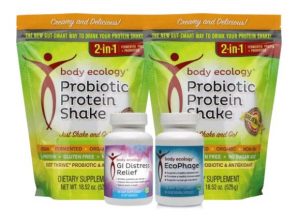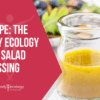
Are you ready for a *new* SIBO protocol?
If you’re one of the many millions of people suffering from SIBO, a question that comes up regularly is whether fermented foods can, or should, be eaten.
We know how much of a trying process it is when it comes to treating digestive issues, so we decided to make things a lot easier for you by creating a SIBO Package that’s 25% off.
Between EcoPhage + Probiotic Protein Shake + GI Distress Relief, you’ll get everything needed to help eliminate bad pathogens, assist motility, repopulate the digestive system with protective probiotics, and even inhibit any additional overgrowth.
Depending on the type of bacteria growing in the small intestine, some people can add in fermented foods while they treat SIBO. It’s easier, however, to initially avoid them until the bacteria has been eliminated.
Once that happens, the process to repopulate with good bacteria should be slow, which we’ll review below.
Indeed, fermented foods and probiotic bacteria like Bacillus, Bifidus, and S. boulardii tremendously help support the recovery from SIBO.1-2 They help strengthen the gut barrier, soothe away inflammation, and minimize the production of gas.
And, it’s important to remember that small intestinal bacterial overgrowth is often the sign of a problem… not the problem itself. Slow motility is one key issue with SIBO.3 The bacteria set up communities and continue to grow — often resulting in gas, bloating, cramping, chronic constipation, and intestinal pain.
Slower motility may be linked to:
- Hypothyroidism
- Leaky gut
- Opioid drug use and prescription painkillers
- Stress, otherwise known as the fight-or-flight response
So, what’s the goal then?Eliminate bacteria in the small intestine and keep it free of bacterial overgrowth, which helps improve motility — and introduce the right fermented foods to support recovery.
Here’s how you can achieve this in a step-by-step process
To begin:
1. Help get rid of bad bacteria by adding in bacteriophages.
Bacteriophages have been around since the early 1900s and haven’t received the attention they deserve, mainly due to antibiotic use. Now, with so much antibiotic resistance, research has been showing promising results from the use of phages for gut health.
Bacteriophages help small intestinal bacterial overgrowth by traveling into the small intestine and immediately recognizing any pathogenic bacteria living where it’s not supposed to be. Then, they attack. They attach to the cell wall of the bad bacteria, leaving the good microbes and cells alone.
Research suggests this can happen fairly quickly.4 Phages also help increase motility — an important step in the process of moving waste through the small intestines.
Our bacteriophages product, EcoPhage, helps motility and even takes things one step further. Not only targeting the bacteria, it also injects its DNA into archaea (microbes). Archaea feed off of hydrogen.
Hydrogen is a byproduct of fermentation that occurs when unabsorbed carbohydrates ferment before they can be broken down. Methane is a byproduct created by the archaea when they feed off hydrogen; this is where flatulence, constipation, and bloating can come into play.
Note: Archaea also can’t be destroyed by an antibiotic. They simply don’t work on archaea. But EcoPhage does.
2. Hone in on specific probiotics.
While killing the bad guys, you’ll also eventually need to beef up the good bacteria in order to keep the small intestine free of bacterial overgrowth:
- The beneficial Bifidus is important for the colon, and the Bacillus and S. boulardii are imperative for the small intestine.
- These also help support a healthy immune system, which your body needs to fight the bacteria and prevent them from re-growing.5
Keep in mind that it helps to use a probiotic not based on how many CFUs it has but based on it having the right bacteria, as mentioned, that will reach the gut and will not be wiped out beforehand. (Our Bacillus reaches the gut with 100-percent survivability.)
Note: Bifidus can be added in when you start to destroy the bacteria. It may also magnify the effects of the phages.
Find out how to reclaim your health with our Body Ecology QuickStart Guide.
3. Include the right probiotic-rich foods, at the right time.
If you have small intestinal bacterial overgrowth, or if you’re experiencing a reaction to high-histamine foods, you’ll want to initially avoid fermented foods because they’re high in lactic acid and histamine. But only avoid them for a certain period of time, just until the bad bacteria are gone.
How do you know when the bad bacteria are gone? Usually, when the pain is under control.
And remember, you can add in Bifidus and phages to your protocol immediately when you start to address small intestinal bacterial overgrowth. Phages only help magnify Bifidus.
Once the bacteria have been eliminated, the first fermented foods to add back in are fermented vegetables made with a culture starter containing bacteria that will be the least offensive to your gut. Lactobacillus plantarum (found in our Culture Starter) is a powerful antiviral that helps degrade histamine and eat oxalates and is resistant to most antibiotics.6
Additionally, the average person may have up to 10 pounds or more of non-eliminated waste in the large intestine. So, an enema followed up with an implant is another way we recommend to help get those pathogens fully out of the small intestine and colon, which in turn can make a person feel better in the event a new elimination diet creates a “die-off” from the yeast and pathogens that are being starved.
Please note to consult with a nutritional genomics practitioner and/or functional medicine doctor before doing an enema, depending on the condition(s) you have.
But basically, this is how you help restore the gut. Slowly.
You’re ready to heal. Where should you begin?
Again, the key is to start slowly, taking one EcoPhage with the two largest meals of the day and 1 to 3 GI Distress Relief with or without meals. (The phages help magnify the Bifidus.)
At the same time, you can add in the delicious and creamy Probiotic Protein Shake. Start with half a scoop, see how you do, and eventually graduate to a full scoop. Enjoy it as a hot protein tea or shake it up with 8 ounces of water. It makes a great morning meal or afternoon snack.
And remember, we made it easy for you to purchase the SIBO bundle that has all of these products at 25-percent off. We love hearing from our amazing customers, so please don’t forget to contact us to let us know how this powerful trio works for you.
REFERENCES:
- 1. Zhong C, Qu C, Wang B, Liang S, Zeng B. Probiotics for Preventing and Treating Small Intestinal Bacterial Overgrowth: A Meta-Analysis and Systematic Review of Current Evidence. J Clin Gastroenterol. 2017 Apr;51(4):300-311. doi: 10.1097/MCG.0000000000000814. PMID: 28267052.
- 2. García-Collinot G, Madrigal-Santillán EO, Martínez-Bencomo MA, Carranza-Muleiro RA, Jara LJ, Vera-Lastra O, Montes-Cortes DH, Medina G, Cruz-Domínguez MP. Effectiveness of Saccharomyces boulardii and Metronidazole for Small Intestinal Bacterial Overgrowth in Systemic Sclerosis. Dig Dis Sci. 2020 Apr;65(4):1134-1143. doi: 10.1007/s10620-019-05830-0. Epub 2019 Sep 23. PMID: 31549334.
- 3. Dukowicz AC, Lacy BE, Levine GM. Small intestinal bacterial overgrowth: a comprehensive review. Gastroenterol Hepatol (N Y). 2007;3(2):112-122.
- 4. Stephen T Abedon, Sarah J Kuhl, Bob G Blasdel, and Elizabeth Martin Kutter. Phage treatment of human infections. Bacteriophage. 2011 Mar-Apr; 1(2): 66-85.
- 5. Stephen T AbedonLau, Amy Sie-Yik, Jin-Zhong Xiao, and Min-Tze Liong. “Bifidobacterium for Infants: Essence and Efficacy.” Beneficial Microorganisms in Medical and Health Applications. Springer International Publishing, 2015. 39-72.
- 6. Kung HF, Lee YC, Huang YL, Huang YR, Su YC, Tsai YH. Degradation of Histamine by Lactobacillus plantarum Isolated from Miso Products. J Food Prot. 2017 Oct;80(10):1682-1688. doi: 10.4315/0362-028X.JFP-17-135. PMID: 28885051.









